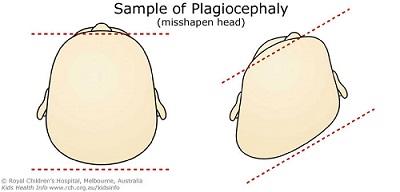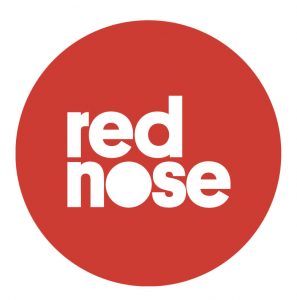Plagiocephaly (or misshapen head) is a very common problem that often causes significant parental concern. However, it is also a highly preventable and treatable condition with the right information at the right time.
What is Plagiocephaly?
Plagiocephaly refers to a misshapen or asymmetrical head shape. It is sometimes referred to as “Deformational Plagiocepahly” or “Positional Plagiocephaly”. A baby with plagiocephaly will usually present with flattening at the back of their head, to one side. In addition, there may be associated secondary changes. These involve the ear and forehead being slightly forward on the same side. Symmetrical flattening at the back of the head is called brachycephaly.
It is important to note that plagiocephaly does not affect the growing brain or your baby’s development.

Image credit: https://www.rch.org.au/kidsinfo/fact_sheets/Plagiocephaly_misshapen_head/
Why do babies get Plagiocephaly?
Newborn babies heads are relatively flexible and this allows them to to pass through the birth canal. However, it also means that they are prone to developing flat spots (plagiocephaly) if they rest in the same position for prolonged periods.
Babies who are premature are more at risk for developing plagiocephaly because they have relatively soft skulls. In addition to plagiocephaly being more common in first born babies, twins and male babies are more likely to be affected.
How do you treat Plagiocephaly?
Counter positioning has been shown to help improve a babies head shape. Counter positioning involves positioning your baby so that the pressure is taken off the flat spot on the back of their heads. As well as during playtime, you can implement counter positioning with carrying positions (i.e. in the pram) and when sleeping (with baby on his/her back and their head turned to the non preferred side).
It is important to note that you should always put your baby on their back to sleep. Parents sometimes ask if it is ok to position their baby on their side or tummy for sleep to take the take the pressure off the flat spot. It is ALWAYS important to place babies on their backs to sleep. This is because there is an increased risk of Sudden Unexplained Infant Death to babies if they sleep on their tummies or sides.
It is important to note that plagiocephaly affects the shape of the skull only and not the development of your baby’s brain. A safe sleeping position should always be paramount. Please see link below about safe sleeping positions: https://rednose.org.au/article/why-back-to-sleep-is-the-safest-position-for-your-baby
Natural History of Plagiocephaly:
Plagiocephaly is very common in new born babies. It affects up to 10-30% of babies at 6 weeks of life. However, the natural history is for improvement over time. Only 3% of children have residual plagiocephaly at 2 years of life. This means that without any input, most babies’ head shape will get better as they grow and develop. We often see significant changes in head shape when babies start to spend more time on their tummies for play.
Why is Tummy Time important to help manage Plagiocephaly?
Tummy time is important to help babies to develop the neck strength required to hold their heads up on their own. Initially, tummy time is difficult for new born babies and this is normal. Importantly though, babies need to practice tummy time. Try to practice lots of small amounts of play in tummy time, giving your baby lots of opportunity to develop their muscles with rests in between.
Engage your baby’s attention by using your face and voice to make tummy time rewarding for your baby. Perhaps you could try different positions like on your chest while you are lying down or over your lap.
Other conditions associated with Plagiocephaly:
Plagiocephaly is closely associated with torticollis. Torticollis is a condition that involves a restriction in a baby’s neck muscles. This results in the baby always resting with their head turned to one side. A baby with torticollis will often require treatment from an experienced Physiotherapist.
If you have concerns about your baby’s head shape, you can consult with one of the following health professionals:
- Physiotherapist with experience working with babies
- Maternal and Child Health Nurse
- GP
Useful Resources:
- RCH Kids Info Fact Sheet: https://www.rch.org.au/kidsinfo/fact_sheets/Plagiocephaly_misshapen_head/
- Australian Physiotherapy Association Fact Sheet – Plagiocephaly: https://choose.physio/your-lifestage/infants-and-children/infant-head-shape
- Red Nose – babies Head Shape: https://choose.physio/your-lifestage/infants-and-children/infant-head-shape
~ Meredith Watson
Paediatric Physiotherapist
https://meredithwatsonphysio.com
You may enjoy these other PMPP paediatric-related blogs:
- https://portmelbournephysio.com.au/paediatric-physiotherapy-motor-development-milestones-2/
- https://portmelbournephysio.com.au/are-your-kids-getting-enough-exercise/
- https://portmelbournephysio.com.au/sporting-injuries-in-adolescents/
- https://portmelbournephysio.com.au/how-to-wear-a-baby/
- https://portmelbournephysio.com.au/physiotherapy-for-children/
- https://portmelbournephysio.com.au/paediatric-physiotherapy/


